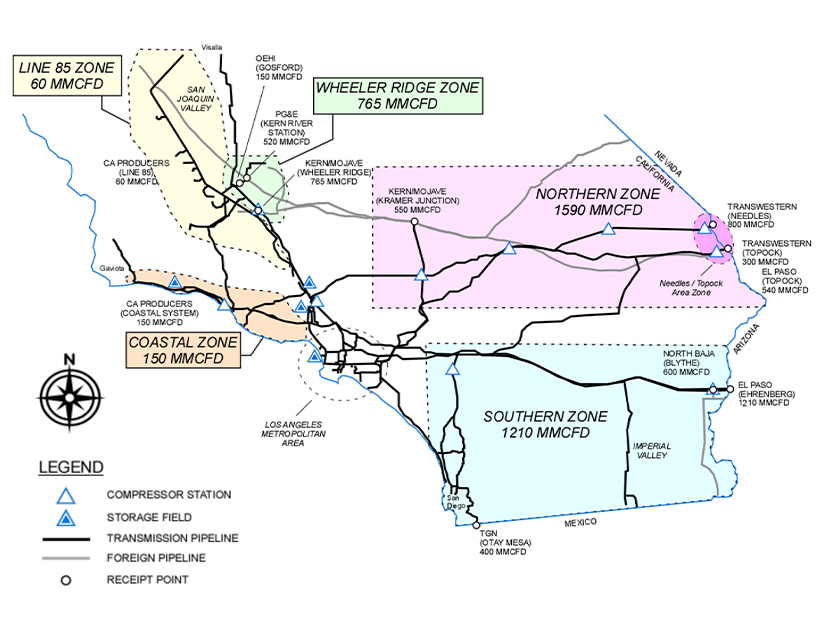
Southern California Gas’ system remains “impaired,” but the risk of service reductions is lower than in previous years because a warm winter forecast could reduce demand for gas-fired electric generation, the California Energy Commission heard Wednesday.
During a joint workshop with the California Public Utilities Commission, Energy Commission staff said two key pipelines are operating at reduced capacity, including one pipeline that ruptured in 2017. An El Paso Natural Gas mainline that ruptured last year south of Phoenix is shut down, limiting supply from the Permian Basin. And storage at SoCalGas’ Aliso Canyon natural gas storage facility continues to be restricted after one of the worst methane leaks in U.S. history in 2015-16.
“Recognizing these restrictions, staff assesses that the risk of service interruptions is lower this winter than in recent winters,” CEC staff wrote in a briefing paper. “This lowered risk is largely due to forecast demand being lower than in prior years. Specifically, staff projects zero curtailment on a winter day cold enough to occur once in 10 years.”
In colder conditions, SoCalGas might have to curtail 280 million cubic feet per day, a tenth of its total pipeline flow of 2.8 million cubic feet per day, the CEC said. The curtailment would affect “noncore load,” mainly electric generators plus some industrial customers and other users.
“Any adverse event, such as a pipeline going out of service, could lead to a higher curtailment,” the CEC report said. “The key risk to reliability is multiday cold weather events with additional infrastructure outages.”
SoCalGas serves nearly 22 million customers, about the same as the population of Florida, in its 24,000 square mile territory.
The CEC’s review is part of its informational proceeding on decarbonization, which it launched with a workshop in June.
“The Energy Commission is making great strides towards enhancing our modeling and analytical capabilities in this winter assessment,” Chair David Hochschild said at Wednesday’s workshop. “We are using our own gas-demand forecast results for the first time, [and] we’ve been able to dig deeper into the winter demand scenarios. All this leads to more verifiable results that feed into the gas decarb.”
Aliso Canyon
Aliso Canyon, regarded as both a threat to public safety and essential for reliability, has been a sticking point in that effort.
Residents and public officials have repeatedly called for its shutdown after it spewed more than 100,000 tons of gas into the atmosphere. The leak was contained after four months and multiple failed attempts.
SoCalGas and parent Sempra Energy agreed to pay $1.8 billion last year to settle the claims of 35,000 residents who claimed they suffered physically and emotionally from the leak.
In November 2021, California’s two Democratic senators, Dianne Feinstein and Alex Padilla, issued a joint statement saying it is “critical that the California Public Utilities Commission outline concrete steps to close this facility while ensuring the reliability of our power grid.”
The storage facility serves more than 11 million customers and provides fuel to 17 gas-fired plants, according to SoCalGas.
“It is a critical part of the region’s energy infrastructure,” the utility says on its website. “More than 90% of Southern Californians depend on gas for heat and hot water, and approximately 60% of all the electricity generated in California is made by natural gas-fired power plants.”
Last November, the CPUC increased Aliso Canyon’s storage limits from 34 billion cubic feet to 41 billion cubic feet because of reliability concerns — still well below its pre-leak capacity of 86 Bcf. Climate change-induced extreme weather “unfortunately has created greater short-term dependency on natural gas generation,” former Commissioner Martha Guzman Aceves said at the time.